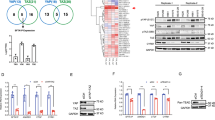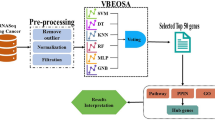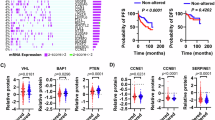Abstract
Lung cancer is one of the most devastating diseases worldwide with high incidence and mortality. Hippo (Hpo) pathway is a conserved regulator of organ size in both Drosophila and mammals. Emerging evidence has suggested the significance of Hpo pathway in cancer development. In this study, we identify VGLL4 as a novel tumor suppressor in lung carcinogenesis through negatively regulating the formation of YAP-TEAD complex, the core component of Hpo pathway. Our data show that VGLL4 is frequently observed to be lowly expressed in both mouse and human lung cancer specimens. Ectopic expression of VGLL4 significantly suppresses the growth of lung cancer cells in vitro. More importantly, VGLL4 significantly inhibits lung cancer progression in de novo mouse model. We further find that VGLL4 inhibits the activity of the YAP-TEAD transcriptional complex. Our data show that VGLL4 directly competes with YAP in binding to TEADs and executes its growth-inhibitory function through two TDU domains. Collectively, our study demonstrates that VGLL4 is a novel tumor suppressor for lung cancer through negatively regulating the YAP-TEAD complex formation and thus the Hpo pathway.
Similar content being viewed by others
Log in or create a free account to read this content
Gain free access to this article, as well as selected content from this journal and more on nature.com
or
Change history
11 August 2021
A Correction to this paper has been published: https://doi.org/10.1038/s41422-021-00551-4
References
Siegel R, Naishadham D, Jemal A . Cancer statistics, 2012. CA Cancer J Clin 2012; 62:10–29.
Jackson EL, Willis N, Mercer K, et al. Analysis of lung tumor initiation and progression using conditional expression of oncogenic K-ras. Genes Dev 2001; 15:3243–3248.
Tuveson DA, Jacks T . Modeling human lung cancer in mice: similarities and shortcomings. Oncogene 1999; 18:5318–5324.
Larsen JE, Minna JD . Molecular biology of lung cancer: clinical implications. Clin Chest Med 2011; 32:703–740.
Zhao B, Lei QY, Guan KL . The Hippo-YAP pathway: new connections between regulation of organ size and cancer. Curr Opin Cell Biol 2008; 20:638–646.
Pan D . Hippo signaling in organ size control. Genes Dev 2007; 21:886–897.
Yin M, Zhang L . Hippo signaling: a hub of growth control, tumor suppression and pluripotency maintenance. J Genet Genomics 2011; 38:471–481.
Pan D . The hippo signaling pathway in development and cancer. Dev Cell 2010; 19:491–505.
Steinhardt AA, Gayyed MF, Klein AP, et al. Expression of Yes-associated protein in common solid tumors. Hum Pathol 2008; 39:1582–1589.
Wang Y, Dong Q, Zhang Q, Li Z, Wang E, Qiu X . Overexpression of yes-associated protein contributes to progression and poor prognosis of non-small-cell lung cancer. Cancer Sci 2010; 101:1279–1285.
Xu MZ, Yao TJ, Lee NP, et al. Yes-associated protein is an independent prognostic marker in hepatocellular carcinoma. Cancer 2009; 115:4576–4585.
Zhang X, George J, Deb S, et al. The Hippo pathway transcriptional co-activator, YAP, is an ovarian cancer oncogene. Oncogene 2011; 30:2810–2822.
Zhao B, Ye X, Yu J, et al. TEAD mediates YAP-dependent gene induction and growth control. Genes Dev 2008; 22:1962–1971.
Schlegelmilch K, Mohseni M, Kirak O, et al. Yap1 acts downstream of alpha-catenin to control epidermal proliferation. Cell 2011; 144:782–795.
Dong J, Feldmann G, Huang J, et al. Elucidation of a universal size-control mechanism in Drosophila and mammals. Cell 2007; 130:1120–1133.
Song H, Mak KK, Topol L, et al. Mammalian Mst1 and Mst2 kinases play essential roles in organ size control and tumor suppression. Proc Natl Acad Sci USA 2010; 107:1431–1436.
Zhou D, Conrad C, Xia F, et al. Mst1 and Mst2 maintain hepatocyte quiescence and suppress hepatocellular carcinoma development through inactivation of the Yap1 oncogene. Cancer Cell 2009; 16:425–438.
Anbanandam A, Albarado DC, Nguyen CT, Halder G, Gao X, Veeraraghavan S . Insights into transcription enhancer factor 1 (TEF-1) activity from the solution structure of the TEA domain. Proc Natl Acad Sci USA 2006; 103:17225–17230.
Knight JF, Shepherd CJ, Rizzo S, et al. TEAD1 and c-Cbl are novel prostate basal cell markers that correlate with poor clinical outcome in prostate cancer. Br J Cancer 2008; 99:1849–1858.
Adelaide J, Finetti P, Bekhouche I, et al. Integrated profiling of basal and luminal breast cancers. Cancer Res 2007; 67:11565–11575.
Nowee ME, Snijders AM, Rockx DA, et al. DNA profiling of primary serous ovarian and fallopian tube carcinomas with array comparative genomic hybridization and multiplex ligation-dependent probe amplification. J Pathol 2007; 213:46–55.
Skotheim RI, Autio R, Lind GE, et al. Novel genomic aberrations in testicular germ cell tumors by array-CGH, and associated gene expression changes. Cell Oncol 2006; 28:315–326.
Chan SW, Lim CJ, Loo LS, Chong YF, Huang C, Hong W . TEADs mediate nuclear retention of TAZ to promote oncogenic transformation. J Biol Chem 2009; 284:14347–14358.
Chen HH, Mullett SJ, Stewart AF . Vgl-4, a novel member of the vestigial-like family of transcription cofactors, regulates alpha1-adrenergic activation of gene expression in cardiac myocytes. J Biol Chem 2004; 279:30800–30806.
Mielcarek M, Gunther S, Kruger M, Braun T . VITO-1, a novel vestigial related protein is predominantly expressed in the skeletal muscle lineage. Gene Expr Patterns 2002; 2:305–310.
Mielcarek M, Piotrowska I, Schneider A, Gunther S, Braun T . VITO-2, a new SID domain protein, is expressed in the myogenic lineage during early mouse embryonic development. Gene Expr Patterns 2009; 9:129–137.
Pobbati AV, Hong W . Emerging roles of TEAD transcription factors and its coactivators in cancers. Cancer Biol Ther 2013; 14:390–398.
Vaudin P, Delanoue R, Davidson I, Silber J, Zider A . TONDU (TDU), a novel human protein related to the product of vestigial (vg) gene of Drosophila melanogaster interacts with vertebrate TEF factors and substitutes for Vg function in wing formation. Development 1999; 126:4807–4816.
Pobbati AV, Chan SW, Lee I, Song H, Hong W . Structural and functional similarity between the Vgll1-TEAD and the YAP-TEAD complexes. Structure 2012; 20:1135–1140.
Richardson AL, Wang ZC, De Nicolo A, et al. X chromosomal abnormalities in basal-like human breast cancer. Cancer Cell 2006; 9:121–132.
Helias-Rodzewicz Z, Perot G, Chibon F, et al. YAP1 and VGLL3, encoding two cofactors of TEAD transcription factors, are amplified and overexpressed in a subset of soft tissue sarcomas. Genes Chromosomes Cancer 2010; 49:1161–1171.
Jin HS, Park HS, Shin JH, et al. A novel inhibitor of apoptosis protein (IAP)-interacting protein, Vestigial-like (Vgl)-4, counteracts apoptosis-inhibitory function of IAPs by nuclear sequestration. Biochem Biophys Res Commun 2011; 412:454–459.
Feng Y, Wang Y, Wang Z, et al. The CRTC1-NEDD9 signaling axis mediates lung cancer progression caused by LKB1 loss. Cancer Res 2012; 72:6502–6511.
Zhao B, Li L, Lu Q, et al. Angiomotin is a novel Hippo pathway component that inhibits YAP oncoprotein. Genes Dev 2011; 25:51–63.
Zhang H, Pasolli HA, Fuchs E . Yes-associated protein (YAP) transcriptional coactivator functions in balancing growth and differentiation in skin. Proc Natl Acad Sci USA 2011; 108:2270–2275.
Muramatsu T, Imoto I, Matsui T, et al. YAP is a candidate oncogene for esophageal squamous cell carcinoma. Carcinogenesis 2011; 32:389–398.
Mann KM, Ward JM, Yew CC, et al. Sleeping Beauty mutagenesis reveals cooperating mutations and pathways in pancreatic adenocarcinoma. Proc Natl Acad Sci USA 2012; 109:5934–5941.
Koontz LM, Liu-Chittenden Y, Yin F, et al. The Hippo effector Yorkie controls normal tissue growth by antagonizing scalloped-mediated default repression. Dev Cell 2013; 25:388–401.
Zhao B, Li L, Guan KL . Hippo signaling at a glance. J Cell Sci 2010; 123:4001–4006.
Hong W, Guan KL . The YAP and TAZ transcription co-activators: key downstream effectors of the mammalian Hippo pathway. Semin Cell Dev Biol 2012; 23:785–793.
Zhao B, Tumaneng K, Guan KL . The Hippo pathway in organ size control, tissue regeneration and stem cell self-renewal. Nat Cell Biol 2011; 13:877–883.
Zhao B, Wei X, Li W, et al. Inactivation of YAP oncoprotein by the Hippo pathway is involved in cell contact inhibition and tissue growth control. Genes Dev 2007; 21:2747–2761.
Sansores-Garcia L, Atkins M, Moya IM, et al. Mask is required for the activity of the Hippo pathway effector Yki/YAP. Curr Biol 2013; 23:229–235.
Sidor CM, Brain R, Thompson BJ . Mask proteins are cofactors of Yorkie/YAP in the Hippo pathway. Curr Biol 2013; 23:223–228.
Guo T, Lu Y, Li P, et al. A novel partner of Scalloped regulates Hippo signaling via antagonizing Scalloped-Yorkie activity. Cell Res 2013. doi: 10.1038/cr.2013.120.
Ji H, Ramsey MR, Hayes DN, et al. LKB1 modulates lung cancer differentiation and metastasis. Nature 2007; 448:807–810.
DuPage M, Dooley AL, Jacks T . Conditional mouse lung cancer models using adenoviral or lentiviral delivery of Cre recombinase. Nat Protoc 2009; 4:1064–1072.
Gao Y, Xiao Q, Ma H, et al. LKB1 inhibits lung cancer progression through lysyl oxidase and extracellular matrix remodeling. Proc Natl Acad Sci USA 2010; 107:18892–18897.
Acknowledgements
We thank Drs T Jacks, R Depinho, K Wong for providing the KrasG12D, Lkb1L/L and p53L/L mice; Drs Kunliang Guan, Bin Zhao, Qunying Lei, Zengqiang Yuan for sharing reagents; Drs Dangsheng Li, Yun Zhao for invaluable comments on the manuscript and Drs Yan Ren, Zhaoyuan Fang, Bin Gao, Yihua Sun, Junhua Zhang for technical supports. This work was supported by Ministry of Science and Technology of China (2012CB910800, 2010CB912102, 2012CB945001), the Cross and Cooperation in Science and Technology Innovation Team program, the Strategic Priority Research Program of the Chinese Academy of Sciences (XDA01010406), the National Natural Science Foundation of China (31370747), Post-Doctor Research Program of Shanghai Institutes for Biological Sciences (2012KIP502, 2013KIP303, 2012KIP401), China Postdoctoral Science Foundation (2011M500826, 2013T60476), the Sanofi-Aventis Shanghai Institutes for Biological Sciences (SA-SIBS) scholarship program and KC Wong Education Foundation Scholarship. The authors gratefully acknowledge the support of SA-SIBS scholarship.
Author information
Authors and Affiliations
Corresponding authors
Additional information
( Supplementary information is linked to the online version of the paper on the Cell Research website.)
Supplementary information
Supplementary information, Figure S1
Detection of VGLL4 expression in NSCLC cell lines (PDF 55 kb)
Supplementary information, Figure S2
Detection of VGLL4 expression in A549 and CRL5872 cells. (PDF 33 kb)
Supplementary information, Figure S3
Different levels of VGLL4 expression in lung tumors from KrasG12D, p53L/L/KrasG12D and Lkb1L/L/KrasG12D mouse models. (PDF 141 kb)
Supplementary information, Figure S4
Statistical analysis of the total number and area lung tumors from LKB1L/L/KrasG12D mice virally infected with Lenti-Ctrl-Cre or Lenti-VGLL4-Cre. (PDF 71 kb)
Supplementary information, Figure S5
Statistical analysis of low grade and high grade tumors from LKB1L/L/KrasG12D mice virally infected with Lenti-Ctrl-Cre or Lenti-VGLL4-Cre. (PDF 52 kb)
Supplementary information, Figure S6
The nuclear co-localization and interaction of VGLL4 and TEAD4. (PDF 74 kb)
Supplementary information, Figure S7
Inactivation of TEADs impairs VGLL4's suppressive role on lung cancer cell growth. (PDF 149 kb)
Supplementary information, Figure S8
Detection of VGLL4 widetype and mutant expression in A549 and CRL5872 cells. (PDF 127 kb)
Supplementary information, Figure S9
Detection of VGLL4 RNAi efficiency in HEK-293T cells. (PDF 29 kb)
Supplementary information, Figure S10
Detection of VGLL4 RNAi efficiency in Beas2B and CRL-5807 cells. (PDF 39 kb)
Supplementary information, Figure S11
Ectopic VGLL4 expression down-regulates the CTGF reporter gene activity enhanced by YAP expression. (PDF 49 kb)
Supplementary information, Figure S12
VGLL4 expression doesn't cause YAP degradation and nuclear exportation. (PDF 172 kb)
Supplementary information, Figure S13
Detection of YAP and VGLL4 expression in A549 cells. (PDF 25 kb)
Supplementary information, Figure S14
VGLL4 inhibits the growth of Hela and HepG2 cells. (PDF 62 kb)
Supplementary information, Figure S15
The second TDU domain is more important for VGLL4's suppressive role on lung cancer cell growth. (PDF 124 kb)
Supplementary information, Figure S16
VGLL1 promotes anchorage-independent growth of A549 cells. (PDF 64 kb)
Rights and permissions
About this article
Cite this article
Zhang, W., Gao, Y., Li, P. et al. VGLL4 functions as a new tumor suppressor in lung cancer by negatively regulating the YAP-TEAD transcriptional complex. Cell Res 24, 331–343 (2014). https://doi.org/10.1038/cr.2014.10
Received:
Revised:
Accepted:
Published:
Issue date:
DOI: https://doi.org/10.1038/cr.2014.10
Keywords
This article is cited by
-
Inhibition of the YAP-MMB interaction and targeting NEK2 as potential therapeutic strategies for YAP-driven cancers
Oncogene (2024)
-
New insights into the ambivalent role of YAP/TAZ in human cancers
Journal of Experimental & Clinical Cancer Research (2023)
-
YAP 5-methylcytosine modification increases its mRNA stability and promotes the transcription of exosome secretion-related genes in lung adenocarcinoma
Cancer Gene Therapy (2023)
-
Loss-of-function mutations of SOX17 lead to YAP/TEAD activation-dependent malignant transformation in endometrial cancer
Oncogene (2023)
-
Complex roles of Hippo-YAP/TAZ signaling in hepatocellular carcinoma
Journal of Cancer Research and Clinical Oncology (2023)



